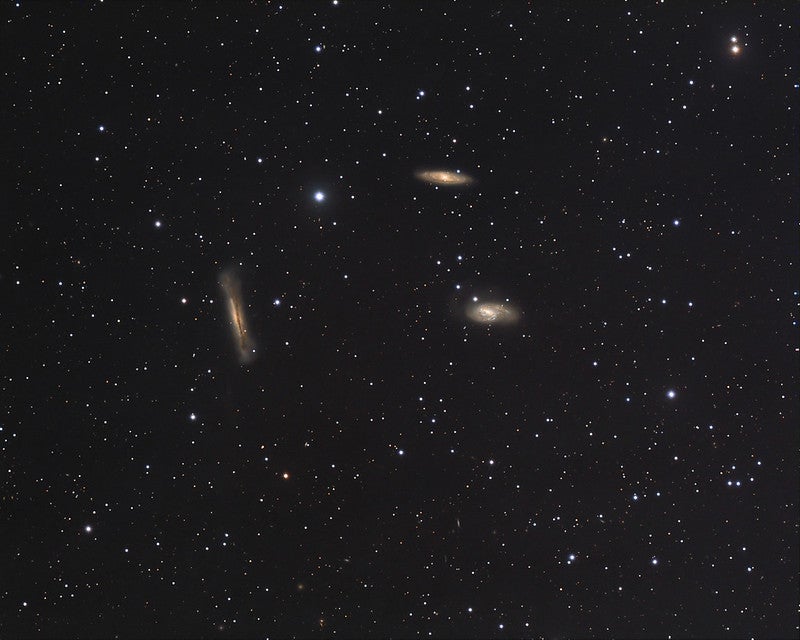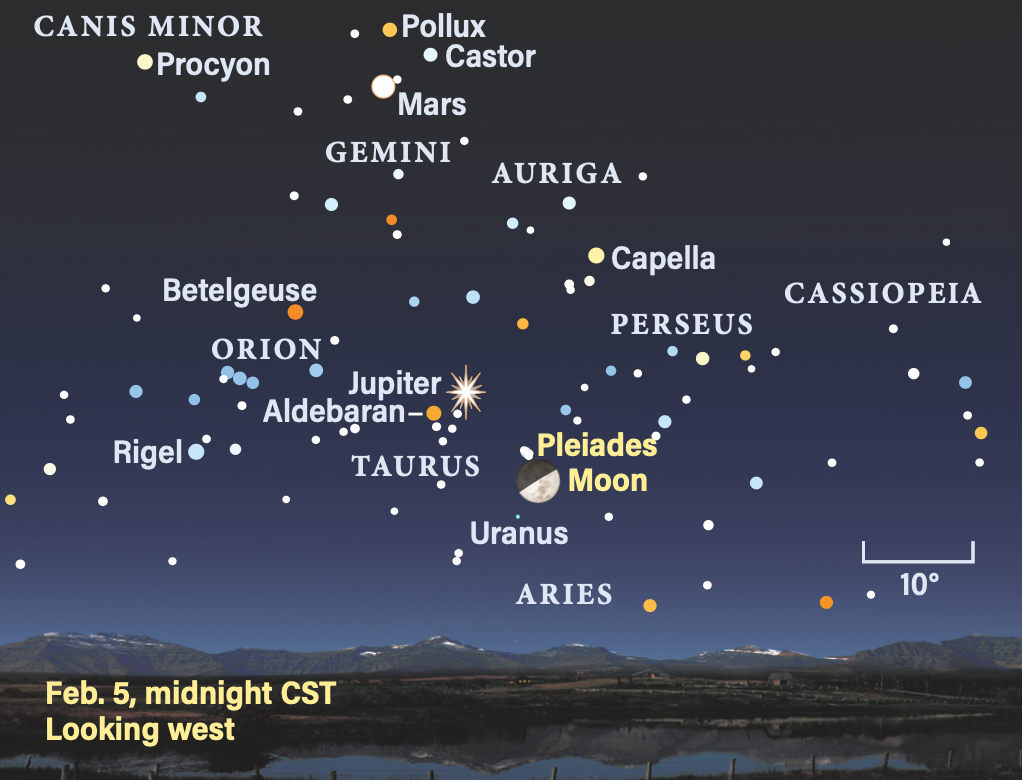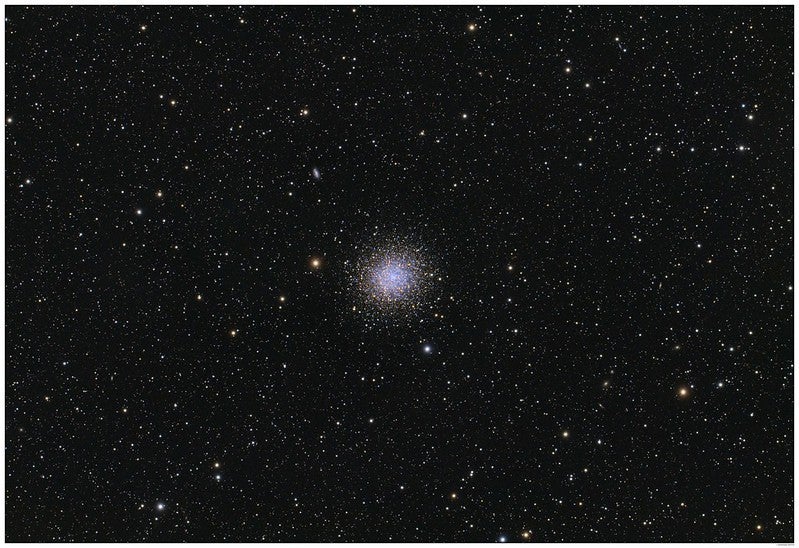Friday, January 31
After passing thru its New section ultimate week, the Moon is now a skinny waxing crescent some 8 p.c lit via sundown this night. You’ll be able to in finding it atmosphere within the southwest as quickly because the Solar is going down, accompanied via Saturn (magnitude 1.1) and Venus (magnitude –4.7) above it.
Saturn sits simply to the Moon’s higher left. Each are in Aquarius the Water-bearer; the Moon will shut in on Saturn as time passes, shifting to take a seat 1.1° due north of the ringed planet in the dark EST. This shall be after the pair has set, on the other hand — they are going to sink under the horizon round 8 P.M. native time.
Venus is upper within the sky, status close to the Circlet of Pisces. It lingers longer after darkish, atmosphere just about an hour later, simply after 9 P.M. native time. You probably have binoculars or a telescope at your disposal, you’ll wish to swing them up towards this planet after darkish. Invisible to the bare eye however smartly inside succeed in of optics, magnitude 7.8 Neptune lies simply over 3° southeast of Venus in Pisces. Search for a small, spherical, “flat” celebrity with a grayish or bluish hue — that’s the far-off ice massive, spanning simply 2” at the sky. Even with the crescent Moon above the horizon, its gentle shouldn’t intervene a lot together with your makes an attempt to look the sun gadget’s farthest planet.
Break of day: 7:09 A.M.Sundown: 5:19 P.M.Moonrise: 8:35 A.M.Moonset: 8:02 P.M. Moon Segment: Waxing crescent (6%)*Occasions for break of day, sundown, moonrise, and moonset are given in native time from 40° N 90° W. The Moon’s illumination is given at 12 P.M. native time from the similar location.
Saturday, February 1Trekking temporarily in the course of the sky, the Moon passes 2° south of Venus at 3 P.M. EST and 1.4° north of Neptune at 6 P.M. EST. By means of sundown within the mid-U.S., the Moon seems to hold simply to the decrease left of Venus, with not up to 2.5° between them. Our satellite tv for pc now presentations off a bigger crescent than the day gone by, with some 15 p.c of its nearside at once lit via the Solar. This may make it somewhat more difficult to identify Neptune within sight with binoculars or a telescope, some 1.2° to the decrease left of the Moon within the early-evening sky.
Whilst you’ve were given your optics out, glance again towards blazing Venus after which proceed 2.5° to the planet’s higher proper (north). You’ll land on a crimson-colored celebrity — that’s 19 Piscium, also known as TX Piscium. This Fifth-magnitude solar is a carbon celebrity, that means it possesses prime amounts of carbon in its environment, which ends up in its deep pink colour. It is usually a variable celebrity — its brightness swings relatively irregularly between magnitudes 4.9 and 5.5, with a coarse duration of about 0.6 yr, or 225 days.
Later this night, the Moon reaches perigee, the nearest level to Earth in its orbit, at 9:47 P.M. EST. Our satellite tv for pc will then take a seat 228,327 miles (367,457 kilometers) away.
Break of day: 7:08 A.M.Sundown: 5:20 P.M.Moonrise: 9:00 A.M.Moonset: 9:16 P.M. Moon Segment: Waxing crescent (13%)
 The Leo Triplet is a bunch of 3 spiral galaxies positioned within the hindquarters of Leo the Lion. Credit score: Andrea Tosatto (Flickr, CC BY-ND 2.0)
The Leo Triplet is a bunch of 3 spiral galaxies positioned within the hindquarters of Leo the Lion. Credit score: Andrea Tosatto (Flickr, CC BY-ND 2.0)
Sunday, February 2Early risers have some nice choices for watching this week, because the Moon units in overdue night and leaves the morning sky darkish.
A couple of hours sooner than break of day, Leo the Lion stays prime within the west, slowly making his manner down towards the horizon. However the well-known Leo Trio (or Leo Triplet) of galaxies we’re after these days is positioned close to the Lion’s hindquarters, giving us a number of time to benefit from the sight sooner than it will get too low.
The brightest celebrity in Leo is magnitude 1.4 Regulus, marking the center of the large cat and positioned within the southwestern portion of the constellation, nearer to the horizon. At the different facet of the celebrity development is the end of Leo’s tail, magnitude 2.1 Denebola. About 8.5° west of Denebola is magnitude 3.3 Chertan, and from right here, it’s a brief hop 2.5° southeast to the Leo Trio.
Easiest seen with as massive a scope as you’ve were given, the Trio incorporates magnitude 9.3 M65 at its southwestern edge. It is a spiral galaxy with a shiny core and fainter palms, although its construction will also be difficult to look. Reasonably brighter is magnitude 8.9 M66, additionally a spiral, some 0.3° southeast of M65.
Finishing the triplet is NGC 3628, about 0.6° north of M66. Sparkling at magnitude 9.5, it’s the faintest of the 3, presenting an edge-on view of its spiral form that makes it glance just a little just like the Cigar Galaxy (M82) in Ursa Main. Like M82 and its within sight neighbor M81, astronomers consider that NGC 3628 not too long ago (smartly, “cosmically” talking, about 800 million years in the past) underwent a gravitational come across with M66.
Break of day: 7:07 A.M.Sundown: 5:21 P.M.Moonrise: 9:24 A.M.Moonset: 10:29 P.M. Moon Segment: Waxing crescent (22%)
Monday, February 3Venus now passes 4° north of Neptune at 3 P.M. EST. The pair is as soon as once more visual within the night sky, striking about 30° above the western horizon an hour after sundown.
Best Venus is visual to the bare eye — it’s the brightest level of sunshine within the sky. With the Moon now a long way above the pair, Neptune must as soon as once more be simple to search out with binoculars or a telescope, its magnitude of seven.8 a long way under the edge of bare eyes. In the event you’re the usage of binoculars, each Neptune and Venus must seem inside the similar box of view.
There’s a vital distinction between the 2, as Neptune seems as a 2”-wide “dot” and Venus a 33”-wide crescent. The interior planet is now 36 p.c lit and waning. In the event you’re in a position, go back to it each and every few days to look at the crescent develop slimmer.
Break of day: 7:06 A.M.Sundown: 5:22 P.M.Moonrise: 9:49 A.M.Moonset: 11:44 P.M. Moon Segment: Waxing crescent (32%)
Tuesday, February 4Jupiter stands desk bound in opposition to the celebs of Taurus at 8 A.M. EST.
The planet is straightforward to search out as quickly because the sky grows darkish, hovering some 65° prime within the southeast an hour after sundown. Its shiny magnitude –2.5 gentle offers Taurus a 2d “eye,” positioned above and fairly to the left of fainter magnitude 0.9 Aldebaran, the Bull’s alpha celebrity.
Jupiter has ruled Taurus for months; this night, it ends its retrograde (westward) movement and starts shifting prograde (eastward) in opposition to the background stars, heading slowly again “out” towards the Bull’s horns.
Additionally extremely visual within the night sky is magnitude –1.1 Mars, positioned to Jupiter’s decrease left in Gemini the Twins. Of the 2 stars that make up the Twins’ heads, Mars is nearer to (and recently facet via facet with) magnitude 1.2 Pollux, whilst fairly fainter (magnitude 1.6) Castor shines above and to the left of the Purple Planet.
Break of day: 7:05 A.M.Sundown: 5:23 P.M.Moonrise: 10:16 A.M.Moonset: —Moon Segment: Waxing crescent (43%)
 On Feb. 5/6, the Moon occults the Pleiades (M45), beginning in a while after 1 a.m. CST. The western 0.33 of the U.S. will be capable to see the entire match. Credit score: Astronomy: Roen Kelly
On Feb. 5/6, the Moon occults the Pleiades (M45), beginning in a while after 1 a.m. CST. The western 0.33 of the U.S. will be capable to see the entire match. Credit score: Astronomy: Roen Kelly
Wednesday, February 5First Quarter Moon happens at 3:02 A.M. EST. Just about part an afternoon later, the Moon passes 5° north of Uranus at 4 P.M. EST, positioned on the border between Aries and Taurus.
However our consideration is indisputably again in Taurus this night, because the Moon occults the Pleiades (M45) celebrity cluster in a single day. Observers within the western U.S. gets to look all of the match, whilst the ones within the jap portion of the rustic will see the Pleiades set with the Moon in the course of the cluster.
You’ll wish to keep watch over the Moon and the Pleiades because the hours tick via this night and the 2 items sink within the west. For the ones within the Midwest, the primary celebrity — magnitude 3.7 Electra — disappears in the back of the darkened western limb of the Moon 1:21 A.M. CST from Kansas Town. You’ll want a transparent western horizon or an increased watching spot from the Midwest, too — this happens with the Moon and cluster simplest 10° prime.
The following celebrity, magnitude 4.1 Merope, disappears from the sky above Kansas Town at 1:57 A.M. CST. The Moon is now simply 4° above the horizon. The ones farther west see extra occultations, together with magnitude 2.9 Alcyone round 1:23 A.M. MST from Denver and and magnitude 3.6 Atlas at 2:08 A.M. MST from Salt Lake Town.
The selection of occultations you’ll see and their timing relies on your location. Take a look at Robert Sandy’s 2025 bight celebrity occultation listings to get main points on your location (or the town closest to you). Word that every one dates and instances are given in Common Time and can wish to be transformed to native time.
Break of day: 7:04 A.M.Sundown: 5:25 P.M.Moonrise: 10:49 A.M.Moonset: 12:59 A.M.Moon Segment: Waxing gibbous (55%)
Thursday, February 6After an early-morning occultation of the Pleiades, the Moon strikes on and passes 5° north of Jupiter in Taurus at 11 P.M. EST. It’s a ravishing pairing that astrophotographers gained’t wish to leave out, with the gibbous Moon striking to the higher left of shiny Jupiter.
Additionally within the night sky, the Large Dipper is mountain climbing within the northeast as darkness falls, circling round Polaris, the North Famous person — the one celebrity in our sky that doesn’t transfer. By means of 9 P.M. native time, the Large Dipper seems to face at the finish of its deal with, a celebrity referred to as Alkaid. The following celebrity in, the place the deal with “kinks,” is in fact two stars: Alcor and Mizar. Mizar is the brighter, extra glaring celebrity — it’s magnitude 2.3. However Alcor is magnitude 4 — additionally throughout the limits of the bare eye. It sits kind of 12’ northeast of Mizar, showing to Mizar’s decrease left because the Large Dipper is status up like this.
Are you able to see each stars with out optical help? In the event you’re having bother, watch for the Dipper to upward push (and rotate) somewhat extra, bringing the tip of the deal with further from the horizon. However, check out taking a look clear of the celebs, conserving them for your peripheral imaginative and prescient. This may lend a hand to deliver out dimmer Alcor in opposition to the background sky.
In the event you take a look at the pair with a telescope, you’ll see that Mizar itself splits right into a double celebrity, with elements some 14” aside.
Break of day: 7:03 A.M.Sundown: 5:26 P.M.Moonrise: 11:29 A.M.Moonset: 2:14 A.M.Moon Segment: Waxing gibbous (66%)
 M13 is among the absolute best globular clusters within the sky, visual close to the Keystone of Hercules and simple to search out within the early-morning sky right now of yr. Credit score: Dominique Dierick (Flickr, CC BY 2.0)
M13 is among the absolute best globular clusters within the sky, visual close to the Keystone of Hercules and simple to search out within the early-morning sky right now of yr. Credit score: Dominique Dierick (Flickr, CC BY 2.0)
Friday, February 7With the Moon nonetheless atmosphere early and leaving a window of darkness sooner than break of day, let’s follow one of the well-known globular clusters within the sky: M13, which lies close to the Keystone asterism in Hercules. This constellation sits to the higher proper of the brilliant, magnitude 0 celebrity Vega in Lyra as those stars take a seat prime within the east round 5 A.M. native time this morning.
The Keystone is made up of 4 stars: As it seems that within the sky this morning, the decrease lefthand nook is magnitude 3.2 Pi (π) Herculis. Shifting clockwise, magnitude 3.5 Eta (η) Herculis sits above Pi, magnitude 2.8 Zeta (ζ) Herculis to Eta’s decrease proper, and magnitude 3.9 Epsilon (ε) Herculis paperwork the Keystone’s decrease righthand nook.
Center of attention at the best of the Keystone — Eta and Zeta — and draw a line between those two stars. About one-third of the way in which from Eta to Zeta (so, beginning on the former and heading towards the latter) is M13. This Sixth-magnitude globular can simply be observed with out optical help underneath just right stipulations, and pops out smartly with any tool. A telescope will display a dense core with scattered stars across the edges. Even a 3-inch scope will display a number of element, as M13 spans about 20’. Upper powers and bigger scopes would possibly display the cluster’s Y-shaped “propeller,” shaped from 3 intersecting mud lanes the place fewer stars are visual.
Break of day: 7:02 A.M.Sundown: 5:27 P.M.Moonrise: 12:18 P.M.Moonset: 3:27 A.M.Moon Segment: Waxing gibbous (76%)

Sky This Week is dropped at you partly via Celestron.

